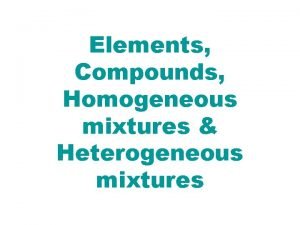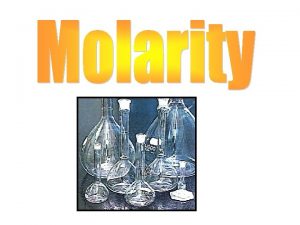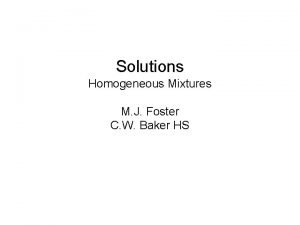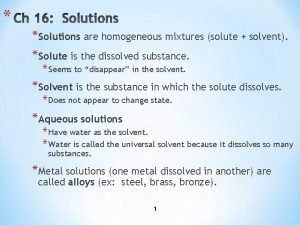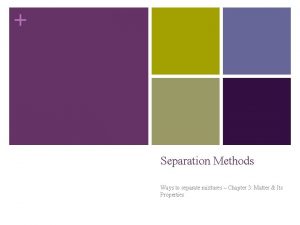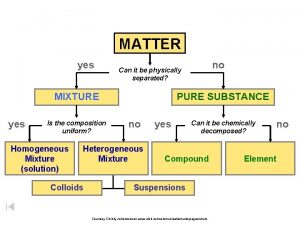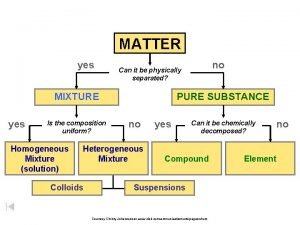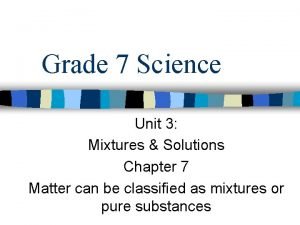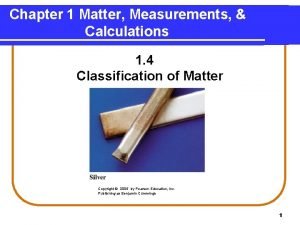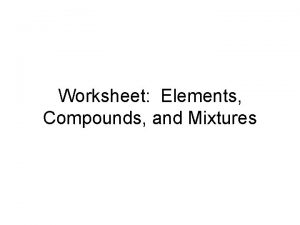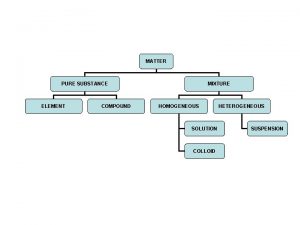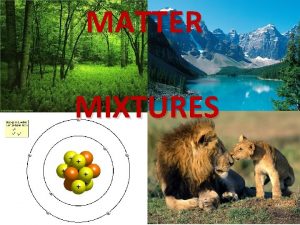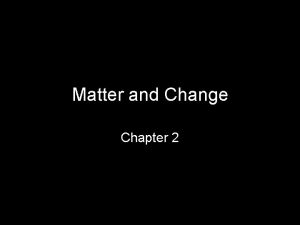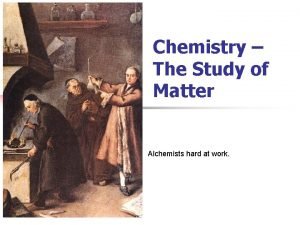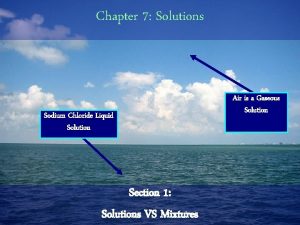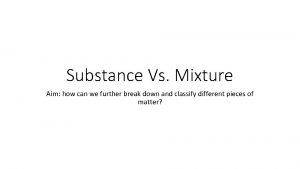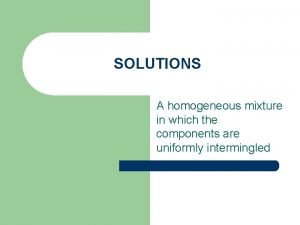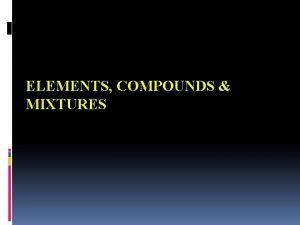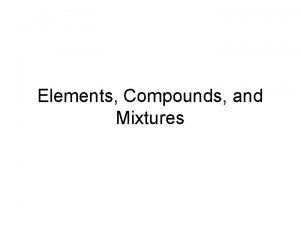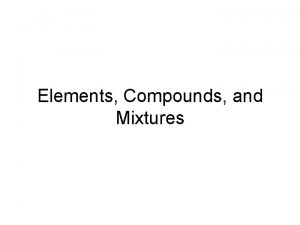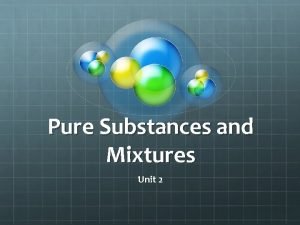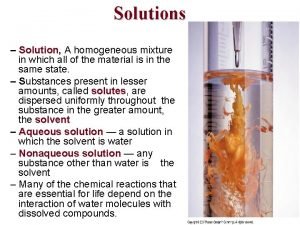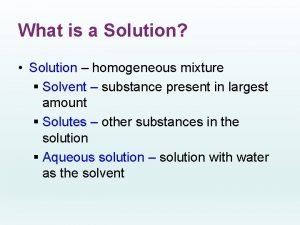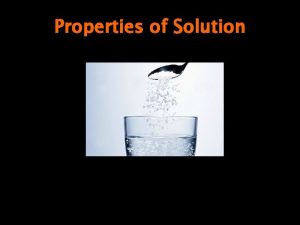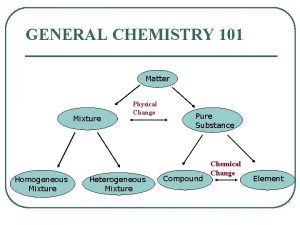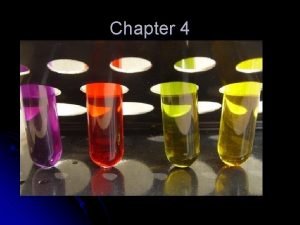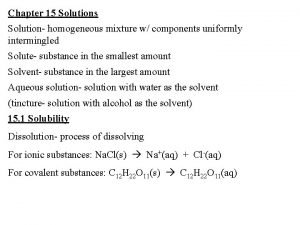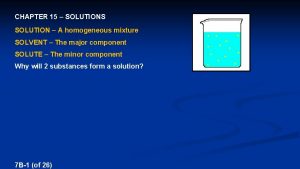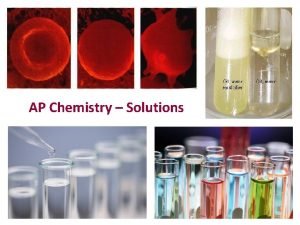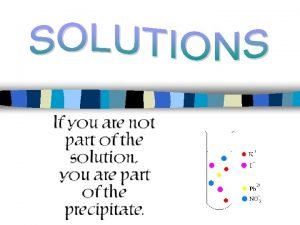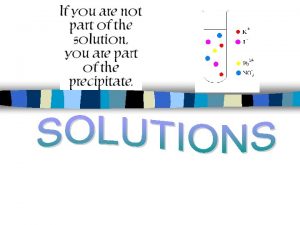Chapter 12 A solution is a homogeneous mixture
































- Slides: 32

Chapter 12

�A solution is a homogeneous mixture composed of two or more substances. In such a mixture, a solute is dissolved in another substance, known as a solvent. A common example is a solid, such as salt or sugar, dissolved in water, a liquid. Gases may dissolve in liquids, for example, carbon dioxide or oxygen in water.

A measure often used in Chemistry is parts per million(ppm) which can refer to mass or volume. The number of parts per million by mass is the mass of a solute in milligrams divided by the mass of solvent in kg. � The number of parts per million by volume is the volume of a solute in microliters divided by the volume of solvent in liters. �

� The molar solubility of a substance is its molar concentration in a saturated solution. A saturated solution is one in which the dissolved and undissolved solute are in dynamic equilibrium with each other. A saturated solution represents the limit of a solute’s ability to dissolve in a given quantity of solvent. Example if we measure the concentration of glucose in its saturated solution at 20⁰C we find it to be 6 mol/L; so the molar solubility of glucose in water at 20⁰C is 6 mol/L.

Temperature: The solubility of a given solute in a given solvent often depends on temperature. For around 95% of solid solutes, the solubility increases with temperature, but gaseous solutes exhibit more complex behavior. As the temperature is raised gases usually become less soluble in water, but more soluble in organic solvents.

� Polarity: "Like dissolves like" This indicates that a solute will dissolve best in a solvent that has a similar polarity to itself. For example, a very polar (hydrophilic) solute such as urea is highly soluble in highly polar water, less soluble in fairly polar methanol, and practically insoluble in non-polar solvents such as benzene.

�Pressure: Henry’s Law states that the solubility of a gas is directly proportional to the pressure of that gas, which may be written as p=kc where k is a constant

Gases can dissolve in liquids: Gases may dissolve in liquids, for example, carbon dioxide or oxygen in water. Gas solubility depends on pressure: A soda bottle can be considered to be saturated since there is some soda above the liquid level and some is in the liquid itself. In an unopened soda bottle there is much higher partial pressure of CO₂ in the neck of the bottle, above the liquid than there is in the air outside the bottle. Due to this difference in the pressure the CO₂ dissolves in the liquid.

� The lowest concentration of oxygen that can support aquatic life is about 1. 3 x 10 -4 mol/L. The partial pressure of oxygen in water at sea level adequate to maintain aquatic life? What is the lowest partial pressure of oxygen that can support life?

� The enthalpy change of solution is the enthalpy change when one mole of a substance is dissolved completely in a large volume of a solvent (forming a dilute solution) at constant pressure. � The formation of a solution involves the interaction of solute with solvent molecules. Many different liquids can be used as solvents for liquid solutions, and water is the most commonly used solvent. When water is used as the solvent, the dissolving process is called hydration. For other solvents it is called as solvation.

� Enthalpy of hydration, Hhyd, of an ion is the amount of energy released when a mole of the ion dissolves in a large amount of water forming an infinite dilute solution in the process, M 2+(g) + m. H 2 O M 2+(aq) where M 2+(aq) represents ions surrounded by water molecules and dispersed in the solution.

� Enthalpies of solution in dilute solution can be expressed as the sum of the lattice enthalpy and the enthalpy of hydration of the compound. � Small, highly charged ions have high enthalpies of hydration.

� Colligative properties of solutions are properties that depend upon the concentration of solute molecules or ions, but not upon the identity of the solute. Colligative properties include � 1. freezing point depression: The difference between the freezing point of a pure solvent and that of a solution. � 2. boiling point elevation: The difference between the boiling point of a solution and that of the pure solvent. � 3. vapor pressure lowering, and osmotic pressure.

� Mole fraction concentration: Mole Fraction concentration is defined as the moles of one component divided by Total Moles of Components in solution. � Mole Fraction of component 1 = X 1 = moles of component 1 / Total Moles of all components in the solution. � Molality of a solution is the number of moles of solute in a solution divided by the mass of the solvent in kilograms

� Determine the mole fraction of KCl in 3000 grams of aqueous solution containing 37. 3 grams of Potassium Chloride KCl. � Convert grams KCl to moles KCl using the molecular weight of KCl 37. 3 grams KCl X 1 mole KCl / 74. 6 grams KCl =0. 5 mole KCl � Determine the grams of pure solvent water from the given grams of solution and solute Total grams = 3000 grams = Mass of solute + Mass of water � 3000 grams = 37. 3 + grams of pure solvent water � 3000 - 37. 3 = grams of pure solvent

� Convert grams of solvent H 2 O to mols 2962. 7 grams water X 1 mol / 18. 0 grams = 164. 6 mols H 2 O � Apply the definition for mole fraction = moles of KCl / Total mols of KCl and water = 0. 5 / 0. 5 + 164. 6 = 0. 5 / 165. 1 = 0. 00303

How many grams of water must be used to dissolve 100 grams of Sucrose C 12 H 22 O 11 to prepare a. 2 mole fraction of Sucrose in the solution? � Determine moles of Sucrose in 100 grams. � 100 grams C 12 H 22 O 11 X 1 mole C 12 H 22 O 11 / 342 grams = 0. 292 moles � Determine mols of solvent water from given mole fraction and moles of solute mole fraction = 0. 2 = moles of Sucrose / mols Sucrose + mols water � Let x = mols water � 0. 2 = 0. 292 / 0. 292 + x � 0. 2 (0. 292 + x) =. 0584 +. 2 x = 0. 292 � x = (. 292 -. 0584)/. 2 = 1. 168 mols water � Convert mols of water into grams 1. 168 mols water X 18. 0 grams water / 1 mol water = 21. 0 grams water �

� Determine the molality of 3000 grams of solution containing 37. 3 grams of Potassium Chloride KCl. � Convert grams KCl to moles KCl using the molecular weight of KCl 37. 3 grams KCl X 1 mole KCl / 74. 6 grams KCl =0. 5 mole KCl Determine the grams of pure solvent from the given grams of solution and solute Total grams = 3000 grams = Mass of solute + Mass of solvent 3000 grams = 37. 3 + grams of pure solvent 3000 - 37. 3 = grams of pure solvent Convert grams of solvent to kilograms 2962. 7 grams solvent X 1 kg / 1000 grams = 2. 9627 kg Apply the definition for molality = moles of KCl / kilograms of solvent = 0. 5 / 2. 9627 = 0. 169 m � � � �

� What is the molality of a Nacl solution prepared by dissolving 10. 5 grams of sodium chloride in 250 g of water? � What is the molality of a solution of benzene, C₆H₆ in toluene, CH 3 C₆H₅ in which the mole fraction of benzene is 0. 150?

� The pressure brought by the vapor in equilibrium with its liquid is called the vapor pressure. � It increases upon increasing the temperature. The vapor pressure of a pure liquid depends on the rate of escape of the molecules from the surface. If the liquid is mixed with another substance, its concentration is decreased and the rate of escape is lowered.

� Raoult's law: The vapor pressure of the solvent in an ideal solution is equal to the mole fraction of the solvent times the vapor pressure of the pure solvent.

� Page 559 - 561 � 12. 5, 12. 6, 12. 13, 12. 36, 12. 38

� When a solute is added to a solvent, the vapor pressure of the solvent (above the resulting solution) is less than the vapor pressure above the pure solvent. The boiling point of a solution, then, will be greater than the boiling point of the pure solvent because the solution (which has a lower vapor pressure) will need to be heated to a higher temperature in order for the vapor pressure to become equal to the external pressure

Pure water microscopic view. Normal boiling point = 100. 0 o. C. 1. 0 M Na. Cl solution microscopic view. Normal boiling point = 101. 0 o. C.

The graph shows the normal boiling point for water (solvent) as a function of molality in several solutions containing sucrose (a non-volatile solute).

� Freezing-point depression describes the phenomenon that the freezing point of a liquid, is depressed when another compound is added, meaning that a solution has a lower freezing point than a pure solvent. This happens whenever a solute is added to a pure solvent, such as water. � This phenomenon may be observed in sea water, which due to its salt content remains liquid at temperatures below 0°C, the freezing point of pure water.


� The addition of 0. 24 g sulfur to 100 g of carbon tetrachloride lowers the freezing point of carbon tetrachloride by 0. 28⁰C. What is the molar mass and molecular formula for sulfur?

� The flow of solvent through a membrane into a more concentrated solution is called as osmosis. The osmotic pressure is proportional to the molar concentration of the solute. � Molarity= osmotic pressure/RT

� In a hypertonic environment, osmotic pressure causes water to flow out of the cell. � In a hypotonic environment has a lower concentration of solute in the environment than in the inside of the cell, making the net flow of water into the cell and eventually causing cell lysis.

� The osmotic pressure due to 2. 20 g of polyethylene (PE) a molecular compound dissolved in enough benzene to produce 100 ml of solution was 1. 10 x 10 -2 atm at 25⁰C. Calculate the average molar mass of the polymer.

� Page 562 � 12. 51, 12. 57, 12. 67, 12. 74,
 Is windex homogeneous or heterogeneous
Is windex homogeneous or heterogeneous What is a solution homogeneous mixture
What is a solution homogeneous mixture Polar mixture
Polar mixture Are solutions homogeneous
Are solutions homogeneous Application of homogeneous differential equation
Application of homogeneous differential equation Homogeneous mixture of a solute in a solvent
Homogeneous mixture of a solute in a solvent How to separate heterogeneous mixtures
How to separate heterogeneous mixtures Composition uniform
Composition uniform What is a uniform composition
What is a uniform composition State of matter
State of matter Mixtures and solutions grade 7
Mixtures and solutions grade 7 Chapter 4 basic food chemistry the nature of matter
Chapter 4 basic food chemistry the nature of matter Blood is heterogeneous mixture
Blood is heterogeneous mixture Vinegar homogeneous mixture
Vinegar homogeneous mixture Mixtures worksheet
Mixtures worksheet Homogeneous mixture
Homogeneous mixture What is homogeneous mixture
What is homogeneous mixture Homogeneous mixture
Homogeneous mixture Homogeneous or heterogeneous mixture
Homogeneous or heterogeneous mixture Flowchart of matter
Flowchart of matter Homogeneous mixture
Homogeneous mixture Juice homogeneous mixture
Juice homogeneous mixture Homogeneous mixture particle diagram
Homogeneous mixture particle diagram Is wine a homogeneous mixture
Is wine a homogeneous mixture Homogeneous mixture
Homogeneous mixture Mixtures and solutions venn diagram
Mixtures and solutions venn diagram Types of homogeneous mixture
Types of homogeneous mixture Is rice a heterogeneous mixture
Is rice a heterogeneous mixture Hungry slide
Hungry slide What is matter
What is matter Homogeneous mixture
Homogeneous mixture Is rice pudding homogeneous or heterogeneous
Is rice pudding homogeneous or heterogeneous Is mouthwash a heterogeneous mixture
Is mouthwash a heterogeneous mixture
